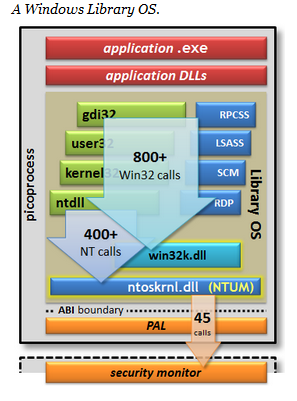Microsoft goes public with its 'Drawbridge' operating-system research project

Microsoft has begun taking the wraps off its hush-hush "Drawbridge" application-virtualization project.

Drawbridge is a new adaptation of the "library OS" concept, as I blogged back in March. Microsoft researchers describe Drawebridge as which Microsoft researchers explain as the library OS concept as:
"(T)he personality of the OS on which an application depends runs in the address space of the application. A small, fixed set of abstractions connects the library OS to the host OS kernel, offering the promise of better system security and more rapid independent evolution of OS components."
In addition to including a Windows-centric library OS, Drawbridge also includes a "picoprocess," which its researchers describe as "a process-based isolation container with a minimal kernel API (application programming interface) surface" inside of which the Windows library OS runs.
As I noted earlier this year, the Microsoft Research Drawbridge team has built a working prototype of a Windows 7 library OS that can run the latest releases of Excel, PowerPoint and Internet Explorer.
From the introduction to the Drawbridge paper:
"Each instance has significantly lower overhead than a full VM bundled with an application: a typical application adds just 16MB of working set and 64MB of disk footprint. We contribute a new ABI (application binary interface) below the library OS that enables application mobility. We also show that our library OS can address many of the current uses of hardware virtual machines at a fraction of the overheads."
The researchers conclude: "Our experience shows that the long-promised benefits of the library OS approach—better protection of system integrity and rapid system evolution—are readily obtainable."
Microsoft published on October 17 a new Channel 9 video with MSR Operating System research manager Galen Hunt and other members of the team explaining Drawbridge
As with all Microsoft Research projects, there is no set timetable as to when or even if Drawbridge will become commercial products or parts of commercial products. However, lately at Microsoft there seems to be more effort to convert MSR experiments into shipping deliverables. So maybe Drawbridge will show up inside a future Windows version -- or maybe even as underlying technology enabling Microsoft to better run existing Windows apps (virtually) on mobile devices?
Update: Another fun codename fact. The mysterious Microsoft Research XAX, which had to do with picoprocesses, also was a precursor/related project to Drawbridge.